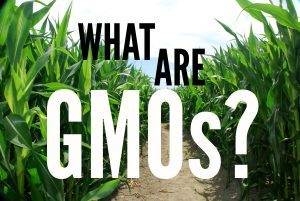
GMOs: What are they and what are their effects?
In 1996, the first Genetically Modified Organisms (GMOs) entered our food supply. Today, genetically modified ingredients are found in 70 percent of our foods. Is it a coincidence, or a direct correlation, that in the nine years since the use of GMOs became commonplace, the number of Americans suffering from three or more chronic diseases nearly doubled from 7 percent to thirteen percent. Have GMOs been contributing to the dramatic rise of obesity, diabetes, asthma, allergies, and other food-related illnesses?
Environmental organizations and public interest groups have been actively protesting against Genetically Modified (GM) foods for years. The results of the few studies that have been conducted have raised grave concerns about the health effects of genetically modified crops on animals, insects, and humans.
What is a GMO?
Genetically Modified Organisms (GMOs, also called “genetically engineered”) are plants, animals, or microorganisms whose genetic code has been altered in order to give it characteristics that it does not have naturally. Genetic engineering of food involves the laboratory process of artificially inserting genes into the DNA of food crops or animals.
The enhancement of desired traits has traditionally been undertaken through breeding or seed hybridization. In traditional breeding it is possible to mate a pig with another pig to get a new variety, but it is not possible to mate a pig with a tomato or a rabbit. And, even when species that may seem to be closely related do succeed in breeding, the offspring are usually infertile – a horse, for example, can mate with a donkey, but the offspring (a mule) is sterile. Additionally, conventional breeding methods are very time consuming and are often not very accurate.
Genetic engineering involves crossing species that could not breed in nature. For example, genes from a fish have been placed in strawberries and tomatoes. The results are plants with traits that would be virtually impossible to obtain with natural processes.
Additionally, genetic engineering can create plants with the exact desired trait very rapidly and with great accuracy. For example, plant geneticists can isolate a gene responsible for drought tolerance and insert that gene into a different plant. The new genetically-modified plant will gain drought tolerance as well. Not only can genes be transferred from one plant to another, but genes from non-plant organisms also can be used.
Although there have been some attempts to increase nutritional benefits or productivity, currently food crops are genetically modified to enhance two main traits– to increase tolerance to herbicides and insects.
With herbicide tolerant GMO crops, farmers can spray large amounts of weed-killer directly on their crops without the risk of also killing the crops. This practice leads to more chemicals in your food.
Insect resistant GMO crops produce pesticides inside the plant. The best known example of this is the use of B.t. genes in corn and other crops. B.t., or Bacillus thuringiensis, is a naturally occurring bacterium that produces proteins that are lethal to insect larvae. B.t. protein genes have been transferred into corn, enabling the corn to produce its own pesticides against insects. This kills or deters insects, saving the farmer from having to spray pesticides. The problem is that the plants themselves are toxic, and not just to insects. When you eat GMO insect resistant corn, for example, it may be like eating pesticides.
Some see GMOs as the way to the future, others believe that scientists have gone too far, tinkering with the essence of life.
Early Warnings About GMOs
Scientists at the FDA warned about possible disasters back in 1991. At the time, there was overwhelming consensus among scientists at the FDA that GM foods were substantially different, and could create unpredictable, unsafe, and hard-to-detect allergens, toxins, diseases, and nutritional problems. They urged the FDA to require long-term safety studies, including human studies, to protect the public.
But, in spite of the protests by the scientists, the warnings were ignored by the FDA, which was under orders by the White House administration at the time to promote biotechnology. As a result, they allowed GMOs such as soybeans, corn, cottonseed, and rapeseeds (canola) with bacterial genes forced into their DNA to enter our diet without any required safety evaluations.
As crazy as it sounds, there have never been any human clinical trials on the effects of GMOs on our health, and not many long-term animal-feeding studies either, so we are largely in the dark about their effect on our population.
GMO Safety Concerns Validated by Studies
There have only been a few safety studies and investigations conducted on GMOs, but those that have, including two recent studies from Austria and Italy, validate the early concerns by the FDA scientists.
On November 13th, 2008, a study by the Italian National Institute of Research on Food and Nutrition showed genetically modified corn caused significant immune system changes in mice, causing allergic reactions and inflammatory responses. The GM corn contains a gene that produces the toxic pesticide called “Bt” in every cell – and in every bite. The results raise the question whether this toxin might be contributing to the rise in allergies or other immune disorders in North America.
Other studies support this contention. The Bt toxin is linked to thousands of deaths among sheep, buffaloes, and other livestock in India that feed on the corn and to widespread allergic reactions in Indian farm workers handling the plants. The corn has also been linked to diseases among people breathing the corn’s pollen.
A second study released last November provokes the question of whether GMOs are the missing link to decreasing fertility. One of the few long-term feeding studies on genetically modified corn was conducted by the University of Veterinary Medicine in Vienna, Austria. They fed GM corn to mice, which then mated. In the third and fourth litters, there was a significant reduction in the number and size of the baby mice.
Similarly in mice fed GM corn for four successive generations (from original mice parents to their great grandchildren), the size and number of offspring tended to be less than the non-GM fed mice.
Other animal feeding studies show similar reproductive problems. Offspring of Russian rats fed GM soy showed a five-fold increase in mortality, lower birth weights, and the inability to reproduce. Italian male mice fed GM soy had damaged young sperm cells. The embryo offspring of GM soy-fed Italian mice had altered DNA functioning. Several farmers reported sterility or fertility problems among American pigs and cows fed GM corn varieties. Cows, buffaloes, and goats in India who were fed GM cottonseed products had miscarriages and premature births.
It is suspected that GMOs affect human health also. Soon after GM soy was introduced to the UK, soy allergies skyrocketed by 50 percent. Many children in the US and Europe have developed life-threatening allergies to peanuts and other foods. There is a possibility that introducing a gene into a plant may create a new allergen or cause an allergic reaction in susceptible individuals.
In March 2001, the Center for Disease Control reported that food is responsible for twice the number of illnesses in the U.S. compared to estimates just seven years earlier. This increase roughly corresponds to the period when Americans have been eating GM food.
Sadly, all of these studies have not been enough to change the practice of allowing GMOs to be used in our food supply, nor have any human studies been required. Without follow-up tests, which neither the GM industry or government are doing, we can’t be absolutely sure if genetic engineering is the cause. But those of us who are concerned about their health effects, can take preventative measures to avoid foods containing GMOs. Part two of this article will tell you the exact foods and products that contain GMOs and which ones don’t.
The Non-GMO Project
Right now there are efforts underway for an industry wide clean up of foods labeled organic and non-GMO. A handful of noble companies took it upon themselves to ensure that consumers could rest assured that their organic and non-GMO foods are truly free of modified genes. They established The Non-GMO Project, which has created an industry-wide consensus-based set of standards and a third-party verification process with testing for GMO content. Companies began to enroll their products in the spring of 2008 and the first non-GMO seals for companies who fully comply with the protocols will be issued in 2009.
The Non-GMO Project Standard is a consensus-based document that has been crafted with the insight and expertise of dozens of individuals, reflecting a dynamic range of perspectives.
Sources
Smith, Jeffrey M., “Genteically Modified Foods: Just Say No.” HealthKeepers Magazine, April 2009, 31-32.
The Non-GMO Shopping Guide, Institute for Responsible Technology, accessed online http://www.responsibletechnology.org
Whitman, Deborah B., Genetically Modified Foods: Harmful or Helpful? April 2000, accessed online http://www.csa.com/discoveryguides/gmfood/overview.php

